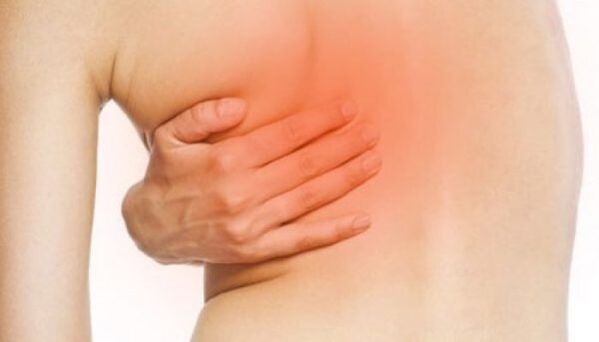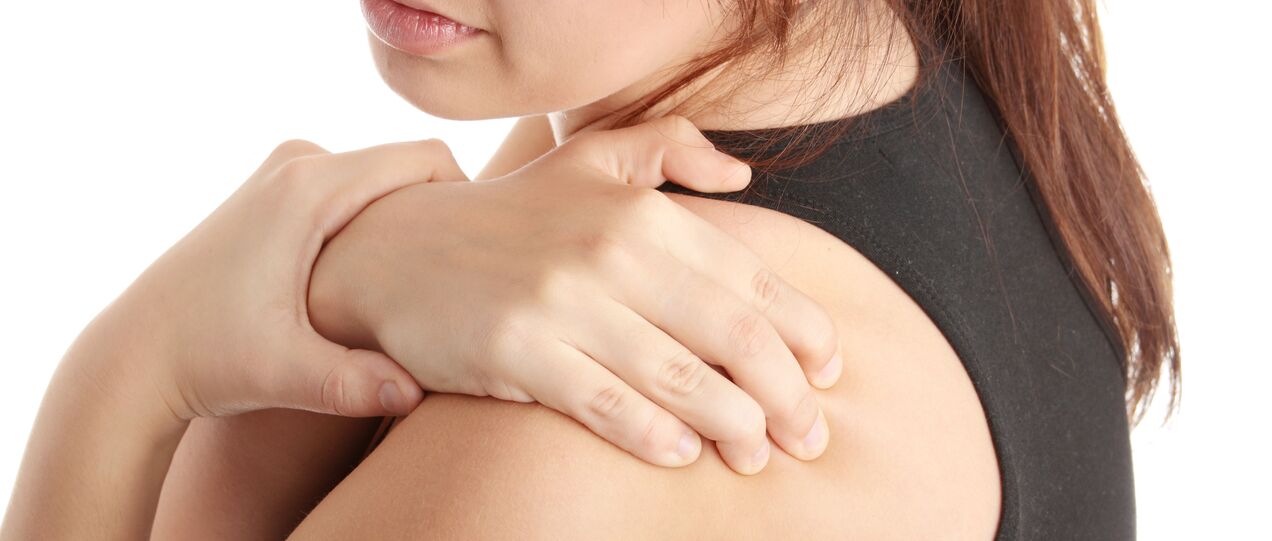Sensation of pain below the collarbone - this symptom can be seen in adults with diseases of the musculoskeletal system or pathologies of internal organs and children who simply do not account for physical activity or standing in a sitting position. clothes.
Self-medication for subdural pain is completely unacceptable: such pain can be a sign of life-threatening conditions.
At the same time, attention and often urgent medical attention deserve not only acute pain, but also a dull ache below the left shoulder blade.
The nature of the pain and accompanying symptoms help suggest a specific illness. However, only a qualified physician, based on patient complaints, can understand which organ damage is causing the pain, prescribe the necessary diagnostic examination and, if necessary, emergency assistance.
Causes of pain under the left shoulder blade in the back from the back

The proximity of the lungs, heart, and spine, as well as an extensive network of nerve fibers, expand the list of possible causes of subperiosteal pain. In this case, each disease is characterized by other specific signs, and the nature and duration of pain also varies.
Pathology of the musculoskeletal and nervous system
Diseases of the spine and musculature of the back are common causes of pain below the left sacrum. Pain in such diseases is usually one-way.
- Osteochondrosis - the formation of bone cells in the chest or cervical spine that causes pulling pain on the left or right side, starting in the neck and upper back, and ending with radiation to the arm. The pain does not go away with rest and is often persistent but tolerable.
- Intercostal neuralgia - accompanied by severe pain radiating throughout the intercostal region and aggravated by breathing, turning, sneezing/coughing. Usually, with neuralgia, the sensitivity of the skin to the source of pain also changes. Neuralgia causes goose-like paresthesias, while numbness below the left shoulder blade often occurs with myocardial infarction, angina attacks.
- Rib syndrome - is a "reward" for strenuous physical work or activities that involve long periods of time in one position (office worker). People complain of dull, non-intense pain localized between the neck and shoulders, radiating below the shoulder blades.
Important! The causes of pain below the left shoulder blade from behind, spreading into the arm and of an urgent nature - osteonecrosis and angina - have a specific character. With angina attacks, the pain lasts up to 30 minutes, with osteonecrosis - several days. Also, angina caused by nitroglycerin or other heart medications stops.
Sometimes subscapular pains are provoked by myositis (simultaneously observed stiffness of movement and tension of certain muscle groups), trauma of the shoulder blades (acute pain, always occurring). preceded by a fall, spanking, etc. ) or cancer (periodic, non-intense pain may occur). Bone tuberculosis, specifically the defeat of the shoulder blades, cannot be ruled out.
Diseases of the heart and blood vessels
Cardiac disease is one of the most dangerous diseases, which can be diagnosed when the patient complains of subdural pain. In this case, the pain in heart disease doesn't always start on the front surface of the chest (behind or to the left of it). Causes of pain below the left shoulder blade, in the heart area can be:
- Angina - pain behind the sternum extending below the left collarbone and collarbone, into the jaw and arm. The intensity of the pain decreased with rest, but the change in body position did not help. With exudative scab syndrome, the pain increases are exactly the opposite. Onset of angina attacks are relieved by taking Nitroglycerin, with vertebral pain manual therapy is excellent.
- Myocardial infarction is an acute, progressive heart attack characterized by irradiation to the left (including subclavian) that is not stopped by cardiac glycosides. The patient feels severe fear, this is not the case with damage to the spine and nerve fibers. Immediate hospitalization needed!
- Hypertensive crisis - often accompanied by a heart attack that radiates to the left shoulder blade. The cause of the pain is easily determined by measuring a/d.
- Pericarditis - with this disease, the pain is relieved at rest and when the trunk is tilted forward. Pain arises in the anterior cardiac region, radiating below the clavicle, but not as intense as in acute myocardial ischemia (angina, myocardial infarction).
- Aortic dissection and aneurysm is a dangerous condition characterized by sharp pain below the collarbone. The rapid increase in pain necessitates an urgent call of the medical team.
Important! For ischemic heart disease (angina attack, heart attack) and cervical osteochondrosis, a sensation of numbness of the tongue on the left side is characteristic.
Important! Often, a symptomatic picture similar to cardiac pathology is presented by vegetative-vascular dystonia. At the same time, the patient's severe illness is clearly fake (psychological factor), the patient is often nervous, shivering, feverish and feeling a lump in the throat.
Respiratory diseases
Pain below the left collarbone can cause the following lung diseases:
- Pneumonia - causes pain only when the focal point of inflammation is near the pleura. Pain of weak intensity arises cyclically, is localized to a point and intensifies with breathing.
- Pleurisy - unlike pneumonia, the pain is sharp, stabbing. Its intensity depends on the depth of the breath.
Pulmonary symptoms accompanied by pain when inhaling under the left shoulder blade are shallow, rapid breathing, shortness of breath, fever. Hyperthermia can also occur with pericarditis. It is extremely rare for a slight increase in temperature to occur with severe neuralgia and myositis.
Important! Unlike heart disease, with pathology of the respiratory tract, pain is accompanied by night sweats and cough (in the early stages of pneumonia, and with pleurisy - dryness).
Diseases of the digestive tract
Pain below the collarbone often accompanies gastrointestinal disorders. In this case, the symptom picture is as follows:
- Peptic ulcer - severe cutting pain always related to food intake (occurs before or shortly after eating), spreads to the fibula with nonspecific localization of the ulcer process (posterior wall of the stomach orits heart). The pain is relieved after vomiting, taking acid-lowering drugs. Perforated ulcer accompanied by increased pain (like being cut by a knife), the patient presses both feet into the abdomen, covering with hands.
- Pancreatitis - accompanied by severe pain of an elastic nature (including under the left shoulder blade). An attack always involves errors in the diet (fatty, salty, fried foods, alcohol, hunger). Vomiting does not bring relief.
Important! Gastrointestinal pathologies, which cause pain under the collarbone on the left side, accompanied by other characteristic symptoms - bloating, indigestion, vomiting, belching.
Diagnosis of subdural pain
When taking the history, the doctor pays attention to the relationship of pain to physical activity, food intake, stress, and also specifies concomitant chronic diseases and recent diseases.
Assessing the nature of the pain, the presence of specific symptoms for diseases of different organs allows you to narrow the range of causes to a specific system of the body - heart, lungs, musculoskeletal system, gastrointestinal tract. The preliminary diagnosis is confirmed by the following studies:
- heart - a/d measurement, ECG, echocardiography and Doppler scan;
- lungs - X-ray of the lungs;
- spine - X-rays of the neck and chest, CT, or MRI.
In the future, a more detailed examination of the damaged organ may be required. Only then is the treatment of the definite disease prescribed.
Which doctor should I contact and when?

Depending on the severity and nature of the pain below the collarbone, the accompanying symptoms, you should consult a doctor:
- urgent emergency call - the pain arises sharply with increasing intensity and the general condition deteriorates rapidly;
- traumatologist - suffers from trauma that causes pain syndrome;
- cardiologist - with concomitant chest pain (persistent or periodic), shortness of breath, cyanosis;
- neurologist, orthopedist - pain below left shoulder blade, aggravated by arm elevation, clear link between pain occurrence and physical activity, degenerative spondylolisthesispreviously diagnosed;
- gastroenterologist - there is a link between pain and food intake, there are other signs of gastrointestinal disease (nausea, vomiting, etc. );
- pulmonologist - pain below the collarbone accompanied by cough, difficulty breathing;
- therapist - pain that occurs without an obvious, permanent, or temporary cause.
The therapist himself often diagnoses both trivial VSD and finds confirmation of an acute surgical pathology or oncological process. In the near future, the doctor appoints a consultation with a specialist in foreskin stenosis.
Preliminary treatment regimens
Depending on the diagnosis, the attending physician selects an effective treatment for the underlying disease. An important point in complex therapy is the elimination of the pain syndrome:
- For neuropathic pain, strong analgesics are most often used;
- Diseases of the spine and muscles requiring a course of treatment with non-steroidal anti-inflammatory drugs;
- Heart disease - pain syndrome requires taking Nitroglycerin (doesn't relieve heart attack), Validol only has a reflex effect, but there is no way to improve the condition of the heart muscle in ischemic disease;
- If gastrointestinal disease is suspected, antispasmodics, acid-lowering drugs (with ulcers) should be used.
Only by eliminating the cause of the disease can the patient get rid of the pain under the fibula. In acute conditions, urgent hospitalization and intensive care are sometimes required.
The degree of thoroughness of the treatment depends on the nature of the disease and the duration of the disease, so at the first painful symptoms, you should consult your doctor. It is not only the outcome of the disease that depends on this, and the chances of a full recovery increase.
In severe cases, prompt medical attention will save the patient's life.

























